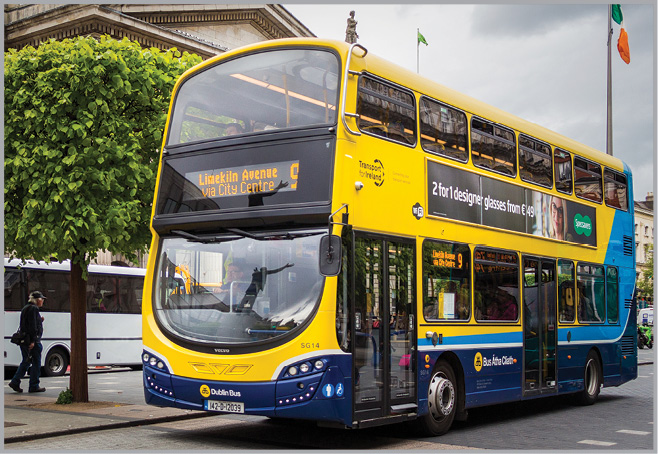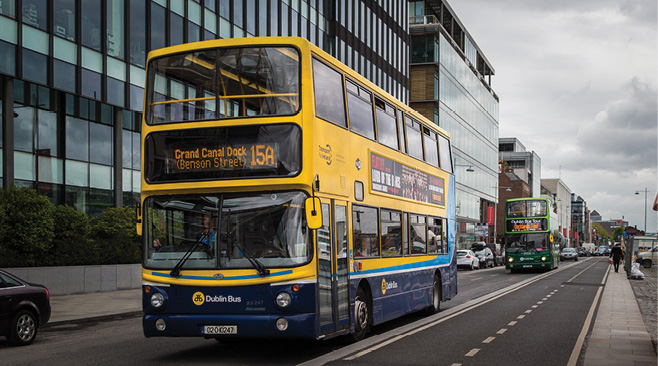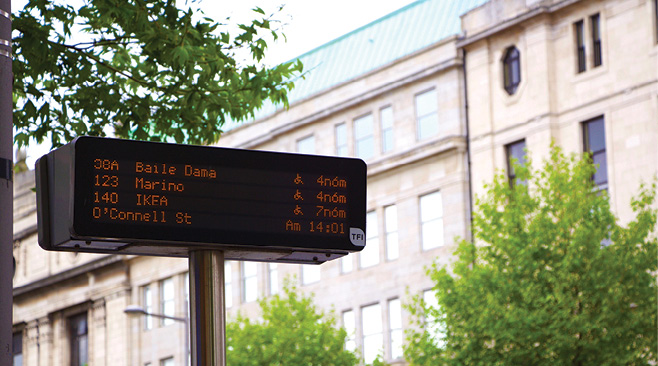Dublin Bus: using technology to increase public transport use


In a relatively small city like Dublin with narrow roads and footpaths, effectively utilising road space for the mass movement of people requires change. This change is necessary if we are to achieve our economic and social aspirations for the city.
Dublin Bus is using technology to enhance customer experience and this has led to a steady increase in the use of public transport in Dublin. In a relatively small city like Dublin with narrow roads and footpaths, effectively utilising road space for the mass movement of people requires change. This change is necessary if we are to achieve our economic and social aspirations for the city. An efficient and effective multi modal public transport system will help meet these aspirations.
Technology has an important role to play in improving the attractiveness of public transport. Dublin Bus has a rich history in adopting technology to improve our services. We strive to bring our customers the latest technologies, whilst offering a quality modern service that is good value for money. This encourages modal shift and promotes the attractiveness of Dublin Bus services and public transport in general. As Ireland’s largest public transport company, with close to 130m customer journeys each year, it is important that we continue to be early adopters of technology for our customers and our economy.
Dublin Bus and technology
Over the past 30 years Dublin Bus has consistently adopted technology to improve our customer experience. Some recent examples of this include the launch of Real Time Passenger Information (RTPI) in 2011. RTPI provides up to the minute information on our bus timetables. With over 96% accuracy on RTPI, Dublin Bus customers benefit from one of the best performing systems worldwide. The introduction of the official Dublin Bus smartphone app which has over 1.5 million downloads to date, has also made public transport more user friendly. It provides our customers with quick, user friendly information by delivering accurate, real time, service information directly to smartphone and handheld devices.
In 2014, Dublin Bus became one of the first public transport operators in Europe to have free Wi-Fi across its entire fleet for customers. In an information hungry society, Dublin Bus has fully embraced social media channels to increase engagement with and enhance service delivery to our customers. Dublin Bus is
currently active on Facebook, Twitter, Snapchat, LinkedIn and Instagram.
As a society we are now more aware of our responsibilities to the environment and our customer feedback reflects this. The latest Fuel Management System technology has been introduced across its seven depots, driving efficiencies in the use of fuel.


Over the next 18 months an eco driving telematics system will be rolled out which will assist our drivers in achieving the optimum fuel use for every journey, with significant benefits to the environment through a reduction in fuel use. Dublin Bus is actively encouraging a migration to cleaner fuel buses, be it hybrid, electric or other forms of sustainable power, and will do all we can to facilitate an introduction to our bus fleet. Dublin Bus is significantly increasing the use of technology in our public offices to provide a more efficient and seamless service to our customers. We assist the National Transport Authority in the delivery of smart ticketing (Leap). None of these improvements are possible without fully engaging with existing and new technologies.
Looking further into the future, technology has the potential to significantly increase public transport use in Dublin. The availability of data and the widespread use of mobile phones enables us to better understand our customers needs. Harnessing this technology and using it to develop new, innovative services is a key part of the company’s vision to help create a world class public transport network in Dublin. The benefits include enhanced urban living opportunities, reduced congestion, improved air quality and reduced noise pollution.
The bus fleet of the future could be exclusively powered by renewable sources of energy. Manufacturers have utilised technology to make this possible now. With effective and efficient rates of vehicle replacement, Dublin Bus can target a public transport fleet driven by renewable sources of power by 2030. Electrification of the bus fleet is one option which would significantly improve the environmental quality of the city centre.
Public transport plays a key role in encouraging the modal shift from the private car to public transport. One of the most dynamic adoptions of technology to assist is Mobility as a Service (MaaS), or integrated mobility platforms. MaaS is an exciting development in the industry using available data and smartphones to provide potential customers with a tailored transport option for their specific needs. This technology provides public transport users with a single interface for all public transport options (via their smartphone). Payment is via a single account and bundled, no matter what mode of transport is used.
Paying for public transport journeys continues to be a barrier to use for some. Simplifying the fare system and making it as easy as possible for customers to pay their fare will assist in achieving modal shift. The roll out of smart card technology (Leap) has been well received by customers to date. Future developments in this area will assist in making payment options as seamless as possible for Dublin Bus customer with the ability to use bank cards, smartphones, smartwatches and Leap cards, among other items, to pay for your public transport use.
Autonomous vehicles will provide an opportunity to enhance the public transport offering and assist in the delivery of on-demand public services, complimenting the wider public transport network.
Toward 2050 – smart transport-smart city
Increasing public transport use and using new technology to provide innovative services will serve to enhance Dublin as the city moves towards becoming a smart city in 2050. Dublin Bus, and public transport in general, has a key role to play in developing an innovative public transport network that will use data, applications, and technology to keep the city moving efficiently.
But first we must prioritise public transport infrastructure and service investment that will provide Dublin city with reliable, punctual, frequent and efficient journeys. This is the foundation of an urban public transport system, upon which we can then build.
Contact:
T: 01 873 4222
W: www.dublinbus.ie






